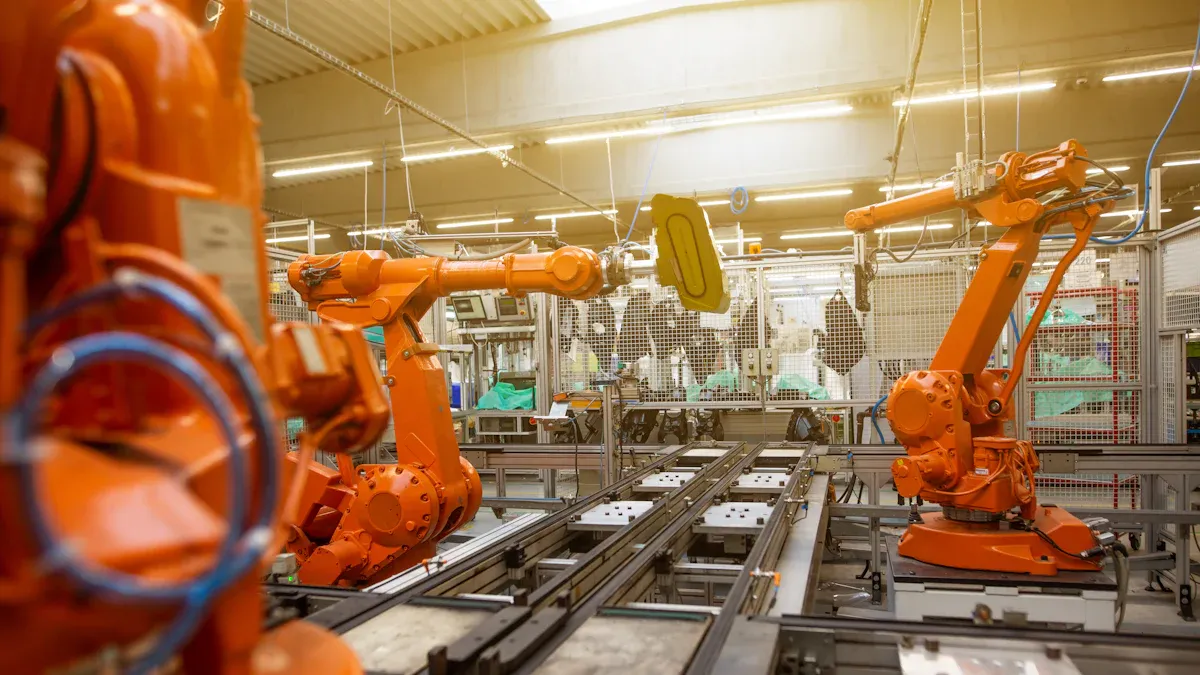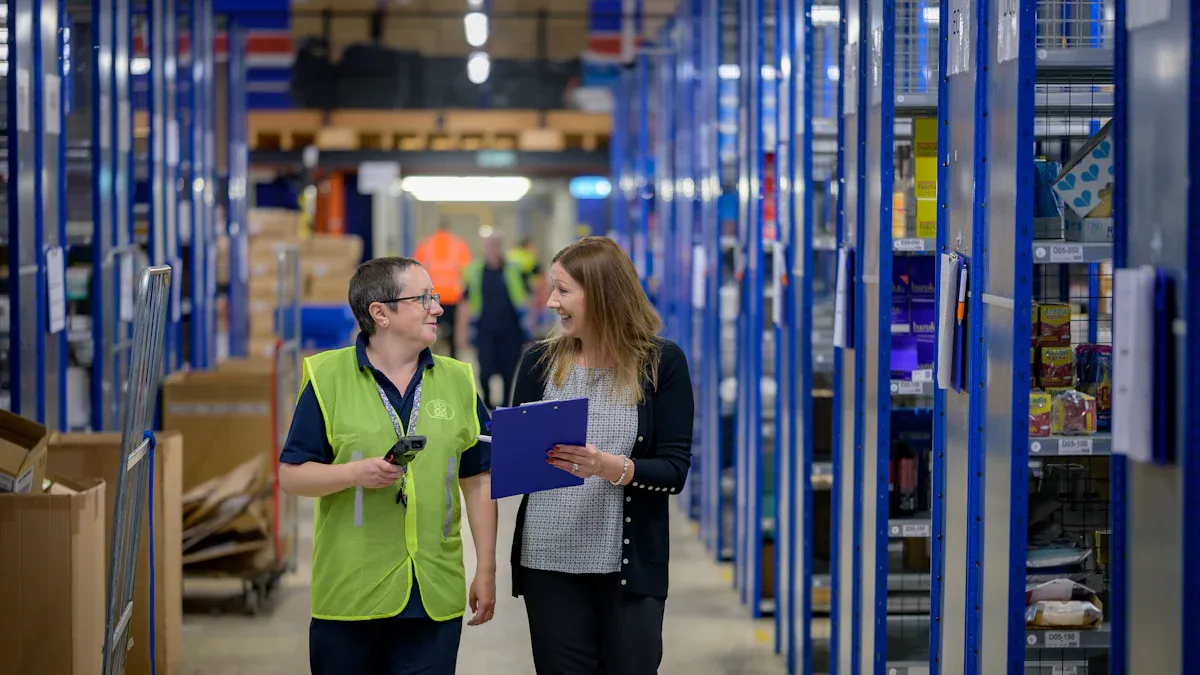Understanding kitting management and its impact on logistics operations

Kitting management in logistics is putting products together in a kit before shipping. This helps save time and lowers mistakes. It also makes the warehouse work better. When kits are ready, orders get filled faster. It is easier to keep track of inventory. These steps help lower costs. Customers are happier because they get the right items quickly and in good shape.
Key Takeaways
Kitting management puts many products in one box. This helps orders get packed faster and with fewer mistakes.
A clear kitting process helps keep track of inventory. It also makes sure every kit has all the needed items.
Technology, like Warehouse Management Systems, makes kitting easier. It does some jobs automatically and shows inventory updates right away.
Kitting saves money by using less packing stuff and sending fewer boxes. This helps your business make more money.
Customers get their full orders quickly, which makes them happy. They return fewer things and trust your brand more.
Kitting management overview

Definition
Kitting management means putting different things together before shipping. This makes one package from many products. Kitting helps with orders that need more than one item. It is like packing all the parts for a project in one box. This way, you save time and make fewer mistakes when sending orders.
Many businesses use kitting to make work easier. In manufacturing, workers put all assembly parts together. Food companies pack ingredients for meal kits. Car makers organize car parts with kitting. Industrial engineers use kitting to manage inventory and spend less money.
Tip: Kitting keeps your warehouse neat and helps you know what is in stock.
Key concepts
You should learn some main ideas to use kitting management well. These ideas make kitting different from other logistics processes.
Key Concept | Kitting Management | Other Logistics Processes |
|---|---|---|
Focus | Grouping items for shipment | Various processes including manufacturing |
Purpose | Assembling items into ready-to-ship kits | Producing goods from raw materials |
Efficiency | Varies based on the specific logistics process |
Kitting uses some important steps and special tools. Here are the main parts:
Component | Description |
|---|---|
A list of items needed to make a kit, so nothing is missing. | |
Storage and Organization | Good shelving and layout help you find items fast. |
Labeling and Tracking | Clear labels and tracking help you manage inventory. |
Technology makes kitting work even better. Advanced systems help you work faster and make fewer mistakes. IoT lets you see where items are right now. AI and machine learning help you choose the best routes and know what to restock. Warehouse Management Systems (WMS) show you your inventory. Cobots help you pack kits more accurately.
Here is how automation and software help kitting:
Automation makes picking, packing, and shipping faster and more correct.
Real-time updates help you change plans when demand goes up or down.
Software links sales and warehouse systems, so you know what you have and need.
Note: Kitting makes logistics operations work better and more accurately. It helps your team do a good job and keeps customers happy.
Kitting in logistics

Process steps
You can make your logistics operations smoother by following a clear kitting process. Kitting in logistics starts with careful planning and ends with a ready-to-ship kit. Here are the main steps you should follow:
Analyze Inventory Data
Look at your inventory to find parts and products that customers often order together. This helps you decide which items to bundle.Assess Customer Demand and Opinions
Check what your customers want. Their feedback can help you design kits that meet their needs.Kit Design and Configuration
Choose the right items for each kit. Create a Bill of Materials (BOM) so you know exactly what goes into every kit.Supplier Collaboration
Work with your suppliers to make sure you always have enough stock for your kits. Sometimes, suppliers can even manage your inventory for you.Packaging and Labeling
Pick the best packaging for your kits. Label each kit clearly so you can track it easily.Logistics and Distribution
Set aside space in your warehouse for kitting. Plan how you will move kits from your warehouse to your customers.Quality Control and Testing
Check each kit to make sure it has all the right parts. Test kits if needed to make sure they work.Inventory Management
Keep track of your kits and the parts inside them. Update your inventory when you use items for a kit.Documentation and Training
Write clear instructions for making kits. Train your staff so everyone knows the best way to assemble and pack kits.Performance Metrics and Continuous Improvement
Measure how well your kitting process works. Look for ways to make it even better.
Tip: When you follow these steps, you can reduce mistakes and make your warehouse run more smoothly.
You can also break down the kitting process into simple actions:
Identify the items you need for a kit.
Pick the items from storage.
Assemble the kit using clear instructions.
Package and label the kit for shipping.
Kitting in logistics lets you bundle related items into one unit. You assign a new SKU to each kit. This makes it easier to track inventory and manage stock. When you sell or ship a kit, your system updates the inventory for each part inside the kit. This keeps your records accurate and helps you avoid running out of important items.
Role in fulfillment
Kitting plays a big role in the order fulfillment process. When you use kitting in logistics, you make it easier to fill orders quickly and correctly. Here is how kitting helps you with fulfillment:
You group all the items a customer needs into one kit. This means you only need to pick and pack one package instead of many.
You reduce the time workers spend searching for parts. Everything is in one place, so they can work faster.
You lower the chance of mistakes. Pre-assembled kits make it less likely that you will forget an item or send the wrong part.
You can ship orders faster, even when you get lots of orders at once. This helps you keep up during busy times.
You can change what goes into a kit to match what a customer wants. This gives you more flexibility in the order fulfillment process.
Note: Kitting in logistics helps you save time and money. It also makes your customers happier because they get the right items, packed together, and delivered on time.
Kitting also helps you manage your inventory better. By creating new SKUs for kits, you reduce clutter in your warehouse. You can track kits and their parts more easily. This makes your whole fulfillment process more efficient.
A well-structured kitting process can:
Shorten the time it takes to fill orders.
Make it easier to handle large numbers of orders.
Reduce errors in picking and packing.
Simplify shipping by putting everything in one box.
Kitting in logistics gives you a strong advantage in the order fulfillment process. You can deliver the right products, faster and with fewer mistakes. This leads to better customer satisfaction and smoother operations.
Kitting management: benefits
Efficiency
Kitting management helps your warehouse work better. You put all needed items together before shipping. This saves time when filling orders. Big companies like Amazon use kitting to make things faster and more organized. Workers do not waste time looking for parts. They pick and pack kits quickly. This means orders get filled faster and logistics work better.
Improvement Type | Description |
|---|---|
Reduced Downtime | Kitting cuts the time workers spend looking for single items. |
Improved Inventory Management | Makes it easier to deliver parts, so nothing gets missed. |
Faster Fulfillment | Orders leave the warehouse fast, so customers wait less. |
Tip: Kitting helps you handle more orders with less work.
Error reduction
Kitting management helps lower mistakes. When you bundle items early, each kit has the right parts. This means fewer errors when picking and packing. For example, a big car company in Texas used kitting to cut mistakes and speed up work. In medicine, kitting helped lower errors in drug orders. These examples show how kitting makes logistics better and order fulfillment smoother.
Industry | Description | Benefits |
|---|---|---|
Automotive | Kitting makes the assembly line work better. | Less time to build, fewer mistakes, and faster production. |
Pharmaceutical | Medicines are packed into kits before shipping. | Fewer errors, easier restocking, and rules are followed. |
Cost savings
Kitting management helps you save money. Kitting lowers costs for packing, shipping, and handling. You ship fewer boxes and use less packing material. This means shipping costs go down and your supply chain works better. Kitting also helps you avoid rush orders and extra fees. These savings make your business earn more.
Improvement Type | Description |
|---|---|
Reduced Costs | Kitting lowers costs for packing, shipping, and handling. |
Improved Inventory Management | Makes it less likely to miss parts, so you avoid rush orders or fast shipping. |
Customer satisfaction
Kitting management makes customers happier. You send complete orders, so customers get everything they need. This means fewer returns and exchanges. Orders arrive faster, which makes customers pleased. Kitting gives a better experience and helps you get good reviews. It also helps build trust and loyalty.
Simple steps mean orders get to customers faster.
Better packaging makes customers like what they get.
Note: Using kitting helps you fill orders better, makes customers happy, and adds value to your supply chain.
Types of kitting in logistics
Kitting in logistics has many forms. You can use different kits for your business. Each type helps with special problems in your supply chain. Here are the main types you will find in logistics kitting.
Assembly kits
Assembly kits have all the parts for a finished product. You use these kits in factories and warehouses. Workers get kits with every part ready to use. This saves time and lowers mistakes on the assembly line. For example, car factories use assembly kits for doors or engines. The table below shows how kitting and assembly are different:
Aspect | Kitting | Assembly |
|---|---|---|
Purpose | Grouping items for convenience in inventory and shipping | Creating a finished product |
Process | Packaging items together | Physically putting parts together |
Application | Used in retail and e-commerce for order fulfillment | Used in manufacturing to produce finished goods |
Efficiency | Speeds up order fulfillment | Focuses on quality and functionality of the final product |
Packaging kits
Packaging kits group products for shipping or selling. You use product kitting to bundle items from one maker or make special deals. For example, you might pack a phone, charger, and headphones together. These kits help fill orders faster and make inventory easier to manage. Packaging kits also use dunnage kits, which protect valuable items during shipping.
Tip: Product kitting helps you sell slow-moving items by bundling them with popular ones.
Custom kits
Custom assembled kits let you make kits for each customer. You can create special kits for unique orders or private label products. These kits give you more space and help workers find items fast. Custom kits lower shipping mistakes and make stock easier to handle. You can use logistics kitting for promo kits or subscription boxes that make customers happy.
You save time by picking one kit instead of many items.
You spend less on shipping by sending one box.
You make work safer and cheaper with fewer pieces to handle.
Note: Custom assembled kits help you meet special customer needs and make your logistics more flexible.
Here is a table showing common types of kitting and what they do:
Type of Kitting | Description |
|---|---|
Full Kitting | Gathering all parts for assembly, important in factories. |
Product Kitting | Grouping products from the same maker. |
Highly Customized Kitting | Making kits for special customer orders. |
Private Label Kitting | Mixing products from different makers under one label, like school kits. |
Promotional Fulfillment | Adding promo items to orders to get repeat buyers. |
eCommerce Fulfillment | Bundling items for subscription boxes or selling slow stock. |
Dunnage Kitting | Using protective materials to keep valuable items safe during shipping. |
Challenges and best practices
Common issues
There are many problems you can face with kitting in logistics. Inventory management is hard if you do not watch items closely. You might have too many or too few items. If your warehouse is messy, it slows down work and causes mistakes. Doing things by hand makes errors happen more often and slows your team. Working with suppliers from different places adds more steps. Customers want their orders faster and want them to be right. Some people ask for special kits, which makes things harder. Late shipments and vendors can mess up your plans. If inventory is not lined up, you can miss deadlines and stop production. These problems can make you lose money and make order fulfillment less steady.
Tip: You can stop many problems by planning well and using technology to track inventory.
Implementation tips
You can fix most kitting problems by using smart strategies. First, learn what your clients need. Make each kit fit their needs. Use good inventory systems for quick updates and automatic reordering. Check quality often and pack kits safely. Make kits small and light to save on shipping. Use technology and data to track kits and make reports better. Build your process so it can grow and change when needed. Work with skilled partners for better services.
Here is a table that shows ways to solve kitting problems:
Challenge | Solution Strategy |
|---|---|
Inventory management complexity | Use smart inventory tools for quick updates. |
SKU management difficulties | Group SKUs together to make work easier. |
Custom packaging demands | Get help from 3PL companies for special packaging. |
Scalability | Use machines to speed up kitting and assembly. |
Quality control | Use machines and checks to keep quality high. |
Set up special areas for putting kits together. Small mistakes can slow down orders, so train your team and use machines when you can. Plan each kit well and guess how much you will need to avoid having too many or too few items. Give enough resources for kitting and connect your warehouse system to match inventory and sales. Check kits before shipping to find problems and make sure every kit is good.
Note: If you follow these tips, you make work faster, lower mistakes, and fill orders quicker. You also make customers happier.
Kitting management helps you do better in logistics. You save time and spend less money. Customers are happier when they get their orders fast. When you put items together in kits, you make fewer mistakes. Shipping is quicker and easier. The table below shows how kitting helps your business grow:
Benefit | Description |
|---|---|
Picking and packing kits saves money. | |
Kits help you use your warehouse better. | |
Boosts sales | Bundled products make people buy more. |
Kitting makes your order process simple and easy to handle.
You can see how well you are doing by checking your savings and how happy your customers are.
Think of kitting management as a smart way to make your logistics better.
FAQ
What is kitting in logistics?
Kitting in logistics means putting different things together. You make one package from many products. This helps you fill orders faster. It also keeps your warehouse neat.
How does kitting reduce errors?
Packing kits early helps lower mistakes. Workers pick one kit, not many loose items. This makes it easier to send the right things.
Can kitting save money for my business?
Yes, kitting helps you save money. You use less packing material and ship fewer boxes. You also spend less time picking and packing.
What types of businesses use kitting?
Many businesses use kitting. Factories, online stores, food companies, and car makers use it. Kitting helps any business that ships products with many parts.
How can technology improve kitting management?
You can use software to track inventory and automate packing. Technology helps you see what is in stock. It makes your kitting process faster and more accurate.
See Also
Essential Lean Manufacturing Principles You Should Know
Understanding Manufacturing Operating Indicators for Improved Outcomes
The Importance of APQP in Automotive and Aviation Industries
A Comprehensive Guide to Jigs and Fixtures in Manufacturing
Key Distinctions Among MPS, MRP, and CRP Explained
About Hunan Puka
Established in 2016 and based in Hunan, China, with a liaison point in Berlin, we are a Tier 2 supplier for the automobile industry. We specialize in the production of customized aluminum die-casting parts designed for machines with a closing force ranging from 280 to 1250 tons, with subsequent manufacturing process CNC machining and surface treatment. Our commitment to quality is reflected in our accredited quality management system, certified by ISO9001:2015 and IATF16949:2016 standards.


